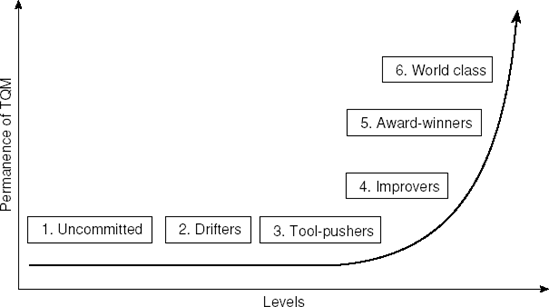Chapter 6. Levels of TQM Adoption
B. G. Dale and D. M. Lascelles
Introduction
From research work carried out world-wide on the subject of TQM by the Manchester School of Management at UMIST during the last 20 years or so, it is clear that the extent to which organizations have adopted and committed themselves to TQM as the ethos of the business is variable. Six different levels of TQM adoption (or lack of it) have been identified, which are termed:
Uncommitted
Drifters
Tool-pushers
Improvers
Award-winners
World-class (see figure 6.1)

Figure 6.1. Levels of TQM adoption Source: Lascelles and Dale (1993)
These levels of TQM adoptions were first derived by Dale and Lightburn (1992) from empirical observation, and were later refined by Lascelles and Dale (1993). The descriptions underlying each of the levels have since been tested by Dale in a number of workshop sessions for senior management in Europe, Hong Kong and South Africa. The initial descriptions of each level have been refined and added to from this testing and the current descriptions are reported in this chapter.
These levels are not necessarily the stages through which organizations pass on their TQM journey; rather, they are characteristics and behaviours which organizations display at one point in time in relation to TQM. While there are obviously exceptions to these generalized descriptions, with some organizations mid-way between ...
Get Managing Quality now with the O’Reilly learning platform.
O’Reilly members experience books, live events, courses curated by job role, and more from O’Reilly and nearly 200 top publishers.

